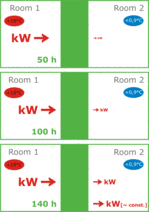U-Value
In the fire protection paragraph, we informed you already that from 1,210°C on a BBS side only 9.5°C penetrated through to the other side. What happens here to the energy from the fire? The energy is almost completely stored by the BBS element. This is why the frying pan handle is made of wood!
"... and what u-value does the BBS thermo wall have?" This is a frequently asked question. What actually is the u-value? In the norm, it means heat transfer coefficient. The u-value is calculated. BBS thermo is a solid building material that insulates heat well and at the same time excellently stores it. This and lots more is not considered by the usual calculation of the u-value.
Store heat and save energy
Measuring the u-value
The u-value can be measured according to EN ISO 8990 in a regulated heater box. This is 2 boxes that are separated by a wall made of light insulating material. A 1 m2 large BBS thermo element is built into this wall. Now room 1 is constantly heated up to approx. 20°C and room 2 constantly cooled down to approx. 0°C. What happens? As is commonly known, heat flows from warm to cold. Thus, it flows through the wall from room 1 to room 2. The u-value is then calculated from this heat flow, but only then when the heat flow, you could also call it heat loss, is constant.
How fast does the BBS thermo wall now lose heat to the outside? One waits about 140 hours, about 6 days, until almost a constant heat flow through the 211 mm BBS thermo wall takes place. The u-value can only be calculated now.
If the u-value is calculated in this way, the important effect of the heat storage is completely ignored. The experiment shows that a larger part of the heating energy used for room 1 has been stored by the BBS thermo wall on the warm side, and transported very slowly to the outside. And what else is not taken into account with all these experiments?
BBS thermo buildings are mostly not in the laboratory, but outdoors, in summer and winter, in the rain or sun.
We are conscious that the u-value of BBS thermo is very important for customers and interested parties. A lot of aid and support depends on this. Nevertheless, this question would be more important „ ... and how much energy does a BBS thermo house actually need“? Nobody asks about the calculated consumption of a car. We all test this for ourselves almost every time we refuel, although we do not get any aid for our cars.
We are not saying that the u-value is an incorrect characteristic. We do not doubt the u- value as such. However, we realise that the u-value, the way it is normally calculated, does not give the correct information about the energy behaviour of BBS thermo. Buildings made of BBS thermo consume considerably less energy than conventional calculations show.
The people, who live in there, know already that this is true.








